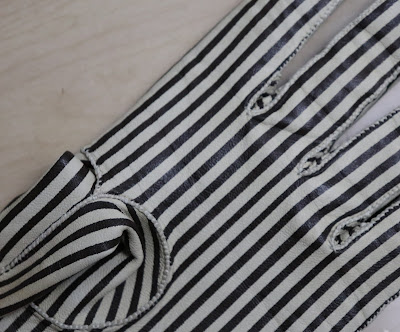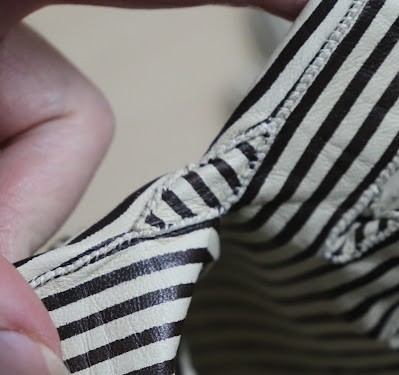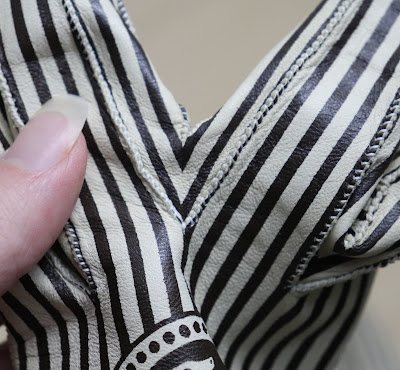I've managed to post this before the end of January this time, hooray!
I never caught up on blogging about a lot of the project from the past few years like I keep meaning to, and I do still mean to finish writing up posts about some of them, but at this point I don't think I need separate posts for every shirt and pair of pants.
Looking at my blogger posts for the past year I see that I made 3 posts about garments from 2022, and only one 2023 garment. Oh my.
Maybe it'll be better this year, now that I have a better workspace. (Or, I mostly have a better workspace, I still need a chair that's tall enough for me to use my desk.)
I think I sewed slightly more this past year than I did the year before, but still not as much as I would have liked.
But in December I had to move, and I was very lucky and ended up renting part of an old house, and now I have an actual sewing room for the first time in my life! It'll be so much easier to get work done with a workspace that's not just one very cramped end of my bedroom!! (Though it is upstairs with no A/C, so summer will probably be even more miserable than usual.)
With this much space it's easier to sew, and easier to film stuff, so hopefully I'll do more than 3 youtube videos this year. In September I finally got my channel monetized, and it's only earning a little bit at the moment, but a little bit is still useful.
And maybe I can finally catch up on blogging now that I have a desk that's not my sewing table. Hopefully some more surface design too, because I didn't work on any repeating patterns at all last year, even though I love surface design and have loads of ideas.
Anyways, here are all the things I finished, in chronological order.
A shirt with the rest of that handwriting print cotton I used for
a very similar shirt back in 2019. (Which is also my most thorough blog post on shirt construction, but I need to make an updated version because I've improved my shirt sewing technique since then.)
A black cotton nightgown. This was a fabric I'd gotten on clearance from Fabricville some years ago, and it turned out to be not very comfortable for a nightgown. It's not too bad, but it has a textured woven stripe in it that makes it a bit rough, so it's always the one I reach for last.
A corduroy jacket. This one was troublesome! I somehow messed up the sleeve pattern really badly, and had to remake the sleeves out of brown corduroy leftover from a pair of pants I made last year. I also used some old sew in interfacing from my stash instead of making buckram, and consequently it's nowhere near stiffened enough and the fronts and pocket flaps are too soft and wrinkly.
A pair of brown cotton pants. The fabric is a pretty cheap cotton tablecloth I found at the thrift store, and the blue facing fabric is also thrifted.
The
1830's patchwork dressing gown! This was on The Pile for years, and now it's finally finished! I'm very happy with it, and with the video I made about making it.
A black shirt, made from more of that textured cotton stripe.
A simple T shaped robe. This was a wearable mockup for an 18th century wrapper (which I have not made yet). It's made of very very cheap cotton from the thrift store, and I added a cat appliqué to the back, based on the cat flag that Frenchie made in the first episode of Our Flag Means Death.
A grey striped nightgown, made from a cotton bedsheet. Someday I will make a nightgown construction post...
A grey wool jacket. Much better than the corduroy one! But unfortunately I can only wear it over dark shirts, because I lined it with burgundy glazed cotton from the thrift store and it stains anything light if I sweat in it.
Edit: I forgot to add the wooly bear caterpillar brooch!
It's made of a little scrap of felted wool with turkey stitch embroidery all over it, which I then brushed with a wire brush.
A red cotton voile shirt. Another fabric I found at the thrift store, and it was such an amazing shade of red that I had to get it and make a dramatic shirt out of it. The sleeves are cut a full metre wide.
Gloves! I'd only made 2 pairs of gloves before this, and that was several years ago, but this fall I decided to try again. This was much better than my first two attempts, but the pattern still needed work.
A pair of pants made out of a floral cotton tablecloth. I tried taking a bit of extra width off the back of the pattern, but I took off too much and they're too tight, so I haven't worn them at all. Oh well.
They were mostly an experiment to see if putting boning in the waistband was a good idea, and it turns out it wasn't.
Another pair of gloves! Pattern improving, but still in need of a few tweaks. The 0.5mm lambskin is from
ItalianSkins on etsy, and it's a better weight for gloves than the goatskin I used for that first pair.
And another pair! These ones are purple leather from Fabricville. I regret buying this hide and I will never buy leather from Fabricville again. It's soft and beautiful, but it's so much weaker than the previous two leathers, and it stains my hands very very purple when it gets wet. bad.
A red linen shirt. Specifically, a shirt made of the summer breeze linen from Pure Linen Envy
in the shade Pomegranate. Somehow the wristbands came out way too small, and I had to piece extra bits onto the ends of both of them.
It goes so well with that grey wool jacket.
Art nouveau gloves. I'm quite proud of these! The design is based on a motif from
an 1898 book which I
re-drew a few times until it fit nicely onto a 1760's glove cuff. Obviously they're not historically accurate, but I think art nouveau and mid 18h century menswear goes very well together.
They're looking a lot rougher now though, because I painted the design on with dye and it smudged and I had to seal it, which made the leather wrinkly. But I can make more easily, and can make an identical pair using paint, which will be better.
A black wool waistcoat. This was on The Pile for at least a year, and I finished it because I finally donated my shabby & very ill-fitting brown wool waistcoat to a local theatre and needed another wool waistcoat to wear. I still need more wool waistcoats to wear.
And another pair of art nouveau gloves! This time in the lousy quality purple Fabricville leather, alas, but with gold paint. I still have enough of this leather to make at least one more pair of gloves, which I'm not happy about, but I bought it so I'm going to use it. I'll just have to make sure to wear them only when the weather is dry.
The last thing I made was this pair of gloves, which I haven't posted publicly anywhere yet because they're the subject of my next
youtube video.
Edit: Finished and posted!
I also made a simple cotton mask, 5 pairs of drawstring pyjama bottoms, hemmed 8 napkins, and did some mending I'd been putting off, but those are all fairly boring. I still ought to do a post on pyjama bottom construction sometime though.
I donated a bunch of old garments to a theatre, and finished some things from The Pile. Some of the things I donated were mostly finished things from The Pile that will never fit me, and they were still happy to take them!
I don't know how many unfinished projects were in The Pile at the start of the year, but a few months ago I went through and counted and wrote them all out in a list, so I can keep better track of how much I have to finish.
I bought a lot of fabric at the thrift store, but only 4 metres of new fabric. I also got some thread, 4 leather hides (plus leather paint & needles), twill tape, and some lace, but I think that's about it. Not too bad for a whole year.
There's a few specific fabrics I want to buy this year, for projects I already have some of the materials for, but hopefully not too much. (Definitely more glove leather though, it turns out that gloves are one of my favourite things to sew.)
I do try to be restrained at the thrift store, but really nice fabric keeps showing up and I simply cannot leave it. I've found multiple pieces of wool suiting there, and even a piece of wool/linen blend!
While I'm happy with most of what I sewed this year, it turns out I did pretty badly on my list of 2023 goals.
"Make it a top priority to eat breakfast immediately upon waking up. This may not sound sewing related, but it definitely helps me accomplish more things." I forgot I had this one on the list. I wasn't successful in having a good breakfast all the time, but I'm pretty sure I did better with it in 2023 than in the previous years. That reminds me, I should get a toaster.
"Make something digitally drawn to-shape and printed using ArtFabrics." I've done a LOT of sketching for printed to shape things, and have got two different designs in progress, but no I haven't actually finished them enough to print and sew them yet. One of them is far enough along that I've done the pattern drafting and scanning, but I haven't started to trace it digitally yet.
"Finish that 1830's patchwork dressing gown." I did! I finished it in early spring and I made a video about it!
"Make more everyday pants. Also repair the holes in the aforementioned 3 pairs of pants." I made two pairs of pants, but one fits so badly that I've never worn them, and I still very much need more pants. I think I patched the holes in two pairs of pants this year? But I wore holes in a couple more, so that's not a net positive. I'd say this one was mostly unsuccessful.
"Replace that damn brown wool waistcoat already." I sort of did! I made a new black wool waistcoat, which I've been wearing a lot this winter, and I donated the shabby old brown one to a theatre. But I do want to make at least one brown one, because the black one doesn't go with my brown pants. I also have an unfinished green wool one on The Pile.
"Make a new batch of dinosaur patterns for Spoonflower." I... don't think I did any work on repeating patterns at all in 2023, aside from a few little concept sketches. Oh dear. Maybe that will change now that I have a desk. (Once I have a taller chair, of course. I can't use my desk with the short chair I have now, or else everything hurts.)
"Try to schedule more of my Patreon posts ahead of time." Nope. I scheduled maybe two or three posts ahead of time in the entire year?
Well, that's... 2.5-ish out of 7? Not great. Ah well! On to the new year!
Goals for 2024:
- Make a very thorough machine sewn shirt tutorial video, and an almost equally thorough tutorial blog post. I've been wanting to do an updated version of my shirt tutorial for ages, and to have both video and text versions. I had planned for it to be my next video months ago, but then I felt like doing a buttonhole tutorial, and then I became obsessed with gloves, but I'm determined to do a shirt video after I finish the glove video!
- Start that 1720's suit that I've wanted to do for several years now. I don't have to finish it this year, but I at least want to start the pattern drafting.
- Make a new winter coat. I've been wearing my Grandpa's old coat for years and the lining is in increasingly bad shape. I'd love to rip it apart and remake it with a new lining, but I can't do that until I have a backup wool overcoat.
- Buy more silk twist, and actually USE it. For some reason I'm still really bad at letting myself spend money on nice thread, and when I do have it I'm very stingy with it. I've still only used silk buttonhole twist on one garment ever, which is silly!
- Take stock of everything in my wardrobe and have a good think about what it's most in need of, and then make more pants because those are still the thing that's most lacking. Some more jackets, waistcoats, and nightgowns would also be great, but ugh I need more pants.
- Finish the design for at least one printed to shape thing. Keeping this goal smaller so maybe I'll actually do it this time. I'll want to fill up as much of the fabric space as I can if I'm having it custom printed, so I don't know yet how much stuff I'll need to do to fill out the rest of the yardage for the thing, but we'll see.
- Reduce the total number of unfinished sewing projects in The Pile. On January 1st it was at 25 (not counting mending & alterations). Mostly garments, but there are a few other things too, and they vary wildly in size, complexity, and completedness.
- Edit: I'm adding an extra goal as of late March, which is to try to limit my buying of new materials as much as I can. Mainly to cut down on spending, but I also have a large stash and would really like to use up more of the stuff in it.
Ok, I think that's enough. 7 things again seems like a good number. Hopefully I'll get more that 2 and a half of them done.
I should get a cork board to put in front of my desk and then put this list on it so it's in front of my face, because I forgot what was on last year's list and didn't go back to look at it.




















































































